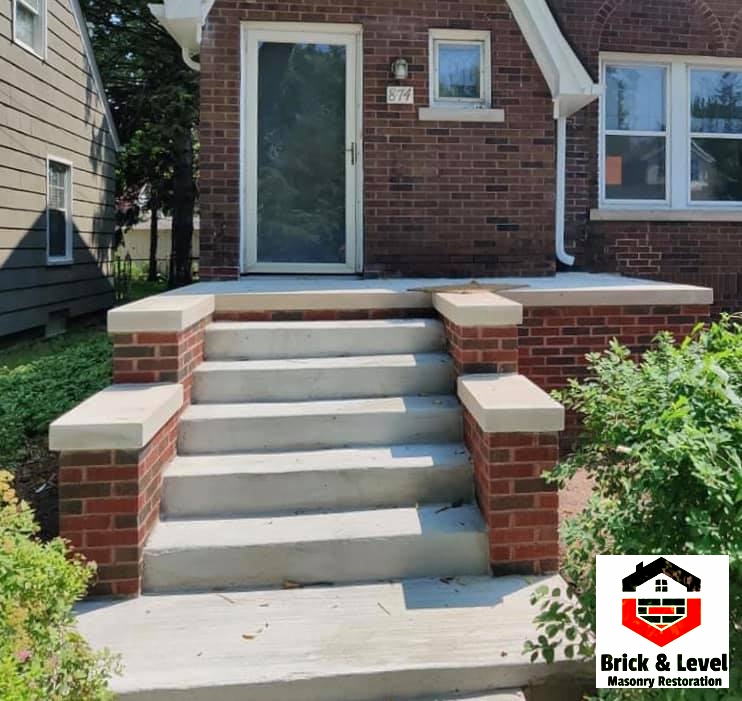What to Look for when Determining a Brick Porch Repair?
When determining a brick porch repair, there are several things to look for:- Cracks: Look for cracks in the brickwork. If the cracks are small and only affect a few bricks, then it may be possible to repair the porch by replacing these bricks. However, if the cracks are widespread and affect many bricks, then the entire porch may need to be replaced.
- Loose bricks: Check if any bricks are loose or have come loose from the porch. Loose bricks can be a safety hazard and can lead to further damage to the porch.
- Unevenness: If the porch is uneven, this can indicate that the foundation has shifted or settled over time. This can cause cracks in the brickwork and can make the porch unstable.
- Water damage: Look for signs of water damage, such as mold or mildew growth on the brickwork. Water damage can weaken the structure of the porch and cause further damage over time.
- Mortar deterioration: Check the condition of the mortar joints between the bricks. If the mortar is deteriorating or cracking, this can lead to loose or unstable bricks.
- Structural issues: If the porch has significant structural issues, such as a sinking foundation, it may be necessary to have the porch completely rebuilt.
What are the steps that are involved in repairing a brick porch?
The steps involved in repairing a brick porch will vary depending on the extent of the damage and the type of repair needed. However, here are the general steps involved in repairing a brick porch:- Inspection: The first step is to inspect the porch for any damage, including cracks, loose bricks, unevenness, and water damage.
- Cleaning: The brickwork needs to be cleaned thoroughly before repair work can begin. This involves removing any dirt, debris, and loose mortar.
- Mortar removal: If the mortar joints are deteriorating, the old mortar needs to be removed before new mortar can be applied.
- Brick replacement: Any bricks that are cracked or damaged beyond repair will need to be replaced. The new bricks should match the existing bricks in size, color, and texture.
- Mortar application: Once the bricks are in place, new mortar needs to be applied to the joints between the bricks. The mortar should be mixed to the correct consistency and applied evenly.
- Finishing: The final step is to finish the repair work. This involves smoothing out the mortar joints and removing any excess mortar. The repaired area should be left to cure for several days before being used.
What to look at when evaluating the brick steps?
Brick steps not only add aesthetic appeal to a property but also serve as a functional and durable pathway. However, over time, weather conditions, usage, and general wear and tear can take a toll on these structures. It is essential for homeowners and property managers to be vigilant and proactive in identifying signs of damage that may require repair. This article aims to highlight key indicators that can help determine if brick steps are in need of repair.- Cracked or Loose Bricks:
One of the most apparent signs that brick steps require repair is the presence of cracked or loose bricks. Inspect the steps thoroughly, paying close attention to each individual brick. Cracks can occur due to shifting ground, frost heave, or excessive weight. Loose bricks can be hazardous and pose a safety risk. If you notice any signs of damage, it is crucial to address them promptly.
- Uneven or Settling Steps:
Uneven or settling steps are not only unsightly but can also be dangerous. Over time, the ground underneath the steps may settle or shift, causing the steps to become uneven. This can lead to a tripping hazard and may indicate a more significant problem with the foundation or support structure. If you notice any irregularities in the levelness of your brick steps, it is advisable to consult a professional to assess the situation.
- Crumbling Mortar Joints:
The mortar joints between the bricks play a crucial role in providing stability and strength to the entire step structure. If you observe crumbling or deteriorating mortar joints, it is a clear indication that the steps are in need of repair. Weather exposure, moisture penetration, and age can cause mortar to weaken and deteriorate over time. Repointing, which involves removing the old mortar and replacing it with fresh mortar, is often necessary to restore the integrity of the steps.
- Water Damage and Efflorescence:
Water damage can have detrimental effects on brick steps. Look for signs of water infiltration, such as discoloration, staining, or dampness on the bricks or adjacent surfaces. Efflorescence, a white, powdery residue on the surface of the bricks, is another telltale sign of moisture-related issues. These signs may indicate poor drainage, inadequate sealing, or compromised water resistance of the bricks. Addressing the underlying water-related issues and repairing any damaged bricks or mortar is crucial to prevent further deterioration.
- Excessive Wear or Erosion:
Brick steps, particularly those that experience heavy foot traffic or exposure to harsh elements, are susceptible to wear and erosion. Inspect the tread surfaces of the steps for signs of excessive wear, such as eroded or broken bricks. If left unaddressed, worn-out steps can become slippery and dangerous, compromising the safety of those using them. Timely repairs or resurfacing can extend the lifespan of the steps and ensure their functionality.
Regular inspection and maintenance of brick steps are essential to ensure their longevity, safety, and visual appeal. By keeping an eye out for signs such as cracked or loose bricks, settling steps, crumbling mortar joints, water damage, and excessive wear, property owners can detect problems early on and take appropriate action. When in doubt, it is advisable to consult with a professional brick mason or contractor who can provide expert advice and assistance in repairing and restoring the beauty and functionality of your brick steps. Remember, prompt repairs not only enhance the overall aesthetic of your property but also prevent potential accidents and save you from costly repairs in the long run.

